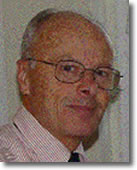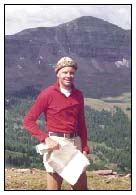Jack P. Simons
 PHYSICAL CHEMISTRY
PHYSICAL CHEMISTRY
Professor Emeritus
B.S., Case Institute of Technology, 1967
Ph.D., University of Wisconsin, 1970
NSF Predoctoral Fellow NSF Postdoctoral Fellow, Massachusetts Institute of Technology,
1971
Office: 330 INSCC
Email: simons@chem.utah.edu
Research Group
Activities & Awards
- Alfred P. Sloan Fellow, 1973-1977
- Camille and Henry Dreyfus Foundation Fellow, 1977-1982
- J.S. Guggenheim Fellow, 1979-81
- David P. Gardner Faculty Research Fellow, 1978, 1981
- University of Utah Distinguished Research Award, 1985
- International Academy of Quantum Molecular Sciences Medal, 1983
- Henry Eyring Chair, 1989
- Chairman, 1996 American Conference on Theoretical Chemistry
- R.W. Parry Teaching Award, 1996
- Award of the Utah ACS, 1998
- D.M. Grant Lecturer, 2003
- R. S. Mulliken Lecturer, Univ. of Georgia, 2003
- Distinguished Alumnus Award,
Case Western Reserve University Chemistry Department 2003 - Rosenblatt Prize, Univ. of Utah 2005
- Journal of Physical Chemistry Festschrift issue, Dec. 2005
- Founder, Telluride Schools on Theoretical Chemistry 2009 (http://www.hec.utah.edu/TSTC/)
- University of Utah Graduate and Postdoctoral Mentor Award, 2010
- W. ChupKa Lecture, Yale University, 2010
- Joseph O. Hirschfelder Prize in Theoretical Chemistry, 2013
- Almlöf-Gropen Lectures at Oslo and Tromsø, Norway, 2017
Research Interests

I enjoy theoretical chemistry because of its tremendous breadth of application and its power in helping us understanding nature's behavior. One has to know a lot of "real" chemistry to be a theoretician, but you also have to be good at thinking of how to quantitatively express, in terms of equations, the behavior and properties of the molecular system you are studying. I have been responsible for a project supported in part by NSF that involved creating a web site at: http://simons.hec.utah.edu/TheoryPage describing what theoretical chemistry is and how it contributes to chemical education and research. I also have a new Cambridge Univ. Press textbook, An Introduction to Theoretical Chemistry, which can be accessed at: http://simons.hec.utah.edu/NewUndergradBook/
In my view, theory seeks (i) to assist in interpreting experimental data both by providing the mathematical equations that relate experimental measurements to molecular properties and by performing computer simulations of experimental situations, and (ii) to search for new chemical species and predict their chemical, physical, and spectroscopic characteristics so that experimentalists can be guided to study them. This ability to study new molecules and new materials, that may involve new bonding situations or unusual chemical structures, is how theory can help in the exciting task of creating "designer materials".
In recent years, our group has been involved in a variety of projects that use theory to study various electron-molecule interaction problems including:
- So-called dipole-bound anions in which the single excess electron is bound largely by the dipole potential of the neutral molecule rather than in an empty or half-filed valence orbital. This work has applications in understanding electron solvation in polar media.
- Doubly- and triply- charged anions in which the Coulomb repulsions among the two or three excess electrons both destabilize the total energy and also produce repulsive Coulomb barriers that inhibit any electron's departure. This work plays an important role in understanding the thermodynamic and kinetic stability (and metastability) of multiply-charged anions in the gas phase and when clustered by solvent molecules.
- DNA anions formed when an electron attaches to a Π orbital of one of the bases of DNA and subsequently causes a distant sugar-phosphate C-O bond cleavage via a through-bond electron transfer event inducing what is called a single strand break. This knowledge is important to the field of radiation damage and for understanding how electrons damage biological systems.
- Peptide fragmentations that occur when an electron attaches to an antibonding disulfide S-S σ or amide π orbital whose energy is Coulomb-stabilized by a nearby positively charged site (e.g., a protonated amine site). This work is helping to unravel the mechanisms by which so-called electron-capture and electron-transfer dissociation (ECD and ETD) mass spectrometry produces characteristic fragmentation patterns, which, in turn, is a key ingredient in peptide and protein sequencing.
Selected Publications
- The Roles of Electrostatics in Forming Molecular Anions and Dianions, J. Simons, and P. Skurski, Recent Res. Devel. Phys. Chem., Theoretical Prospect of Negative Ions, J. Kalcher, Ed., 117-138 (2002).
- An Introduction to Theoretical Chemistry, J. Simons, Cambridge University Press (2003).
- Model Calculations Relevant to Disulfide Bond Cleavage via Electron Capture Influenced by Positively Charged Groups , A. Sawicka, P. Skurski, R. R. Hudgins, and J. Simons, J. Phys. Chem. B107, 13505-13511 (2003).
- Damage to Model DNA Fragments from Very Low-Energy (<1 eV) Electrons, J. Berdys, I. Anusiewicz, P. Skurski, and J. Simons, J. Am Chem. Soc. 126, 6441-6447 (2004).
- Effects of Base Π-Stacking on Damage to DNA by Low-Energy Electrons, I. Anusiewicz, J. Berdys, M. Sobczyk, P. Skurski, and J. Simons J. Phys. Chem. A108, 11381-11387 (2004).
- Equations of Motion (EOM) Methods for Computing Electron Affinities and Ionization Potentials, J. Simons, pp. 443-461 in Theory and Applications of Computational Chemistry: The First 40 Years, A Volume of Technical and Historical Perspectives, Clifford E. Dykstra, Gernot Frenking, Kwang S. Kim, and Gustavo Scuseria, Eds., (2005).
- Coulomb-Assisted Dissociative Electron Attachment: Application to a Model Peptide, I. Anusiewicz, J. Berdys, M. Sobczyk, A. Sawicka, P. Skurski, and J. Simons, J. Phys. Chem. A109, 250-258 (2005).
- Distance Dependence of Through-bond Electron Transfer Rates in Electron-Capture and Electron-transfer Dissociation, M.. Sobczyk and J. Simons, Inter. J. Mass. Spec., 253 274-280 (2006).
- The Role of Excited Rydberg States in Electron Transfer Dissociation, M. Sobczyk and J. Simons, J. Phys. Chem. B 110, 7519-7527 (2006).
- Simulating Electron Transfer Attachment to a Positively Charged Model Peptide, I. Anusiewicz, J. Berdys-Kochanska, P. Skurski, and J. Simons, J. Phys. Chem. A 110, 1261-1266 (2006).
- Distance Dependence of Through-bond Electron Transfer Rates in Electron-Capture and Electron-transfer Dissociation, M. Sobczyk and J. Simons, Inter. J. Mass. Spec., 253 274-280 (2006).
- The Role of Excited Rydberg States in Electron Transfer Dissociation, M. Sobczyk and J. Simons, J. Phys. Chem. B 110, 7519-7527 (2006).
- How Do Low-energy (0.1-2 eV) Electrons Cause DNA Strand Breaks? J. Simons, Acc. Chem. Res. 39, 772-779 (2006).
- Streaming videos on electronic structure theory: http://www.hec.utah.edu/ESTheory/ (2007)
- Molecular Anions, J. Simons, J. Phys. Chem. A 112, 6401-6511 (2008).
- Mechanisms for S-S and N-Ca Bond Cleavage in Peptide ECD and ETD Mass Spectrometry, J. Simons, Chem. Phys. Lett. 484, 81-95 (2010).
